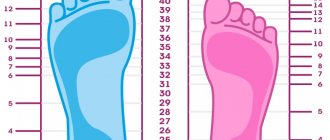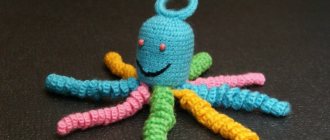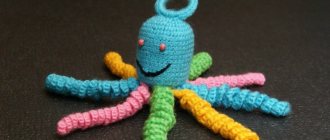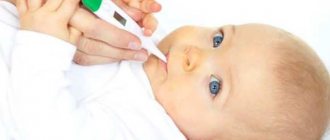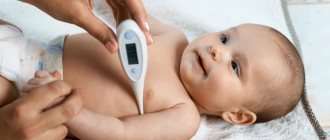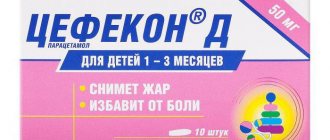Roseola is a common and usually harmless viral infection found in infants and toddlers. Other names for infantile roseola: sixth disease, sudden exanthema, three-day fever. Roseola usually goes away on its own in about a week, and you shouldn't worry too much about its symptoms. Usually, with a typical picture of roseola, a child has a high fever for three days, after which a rash appears (faint red spots ranging in size from 2 to 10 mm, disappearing when the skin is stretched). But with a mild form, you may not notice any symptoms at all. Some symptoms of roseola require home treatment to relieve discomfort (for example, if you have a high fever, give an antipyretic). In this article, you will learn what roseola is in children, how roseola symptoms appear, and when you should see a doctor.
What is roseola
Roseola is an infection caused by the herpes simplex virus type 6 or type 7. Young children aged 6 months to 2 years are especially susceptible to it. Most often it occurs between the ages of 6 and 15 months. Babies have immunity to roseola for some time after birth, acquired with antibodies from their mother. Young children who have had roseola acquire immunity to the virus. Re-infection does occur, but is extremely rare. When children get sick with roseola, they recover within a week on average.
Causes
Roseola or sudden exanthema is caused by the sixth type of herpes virus, which affects children aged from six months to 3-4 years. Most often children are sick for about a year.
In children over five years of age, roseola practically does not occur. Previously, it was often mistaken for manifestations of rubella, and therefore, in the future, children were not fully vaccinated against rubella.
Roseola is often undiagnosed as a disease and is mistaken for other childhood infections, but most often it is considered an allergic rash to medications.
Photo: website of the Department of Dermatovenereology of the Tomsk Military Medical Institute
What are the symptoms of roseola?
The incubation period for roseola is 7–14 days, which means this is how long it can take from the moment of infection to the appearance of symptoms. Symptoms of roseola:
- Heat
The baby may suddenly have a fever of 39–40 degrees. With infantile roseola, the temperature can last for three to five days.
- Rash
When the temperature begins to subside, a non-itching rash may appear: many small, non-convex pink dots or spots. Sometimes the rash may be raised or have a white rim. The rash may appear on the chest, back, abdomen, and then move to the neck and arms, and in some cases to the legs and face.
- Enlarged lymph nodes
- Slightly red throat
- Runny nose
- Cough
- Moody mood
- Drowsiness
- Mild diarrhea
- Decreased appetite
- Puffy or drooping eyelids
Symptoms
- First of all, there is an increased temperature (up to 41 degrees Celsius). It is accompanied by a sore throat, severe cough, runny nose, and rashes appear on the body. A high temperature is the first indicator that there is a virus in the blood. This state lasts for three days;
- the patient's neck and body are covered with small pale pink spots in large numbers; the face, hands and feet are less vulnerable. Basically, a pale rim appears around the rash;
- after a few days, and depending on the disease and weeks, the rash disappears.
Roseola infantis, whose symptoms do not appear in the first three days, is difficult to diagnose. The appearance of a temperature is not a characteristic sign, and only rashes indicate roseola disease.
How to make a diagnosis
The symptoms of roseola are similar to those of many other common childhood illnesses, so it may be difficult for your doctor to recognize it right away. The doctor may wait for the rash to appear to confirm the diagnosis, especially if the possibility of illnesses such as a cold, ear infection (otitis) and streptococcal throat infection has already been ruled out. If the fever does not subside and/or your child's condition worsens (for example, the symptoms listed here develop), the doctor may order blood, urine, or other tests to confirm or rule out roseola.
Treatment of roseola in children
Despite the high temperature, roseola does not pose any danger to the baby. The child’s body almost always copes well with the disease on its own; pseudorubella is a rare type of disease that does not require specific treatment.
The exception is the case when the child’s immunity is suppressed for various reasons. Then the doctor will additionally prescribe Acyclovir, the drug will help cope with the virus, alleviate the baby’s condition, and speed up the recovery process.
In all other situations, the baby is prescribed bed rest, walks in the fresh air after the fever subsides, and drinking plenty of fluids to remove toxins from the body. Additionally, wipe the baby's body and head with a wet towel to quickly cool the body at high temperatures, do not allow the baby to overheat.
Roseola is a contagious disease; limit contact with other children for several weeks; contact with adults is also undesirable. To reduce the likelihood of infection, frequently ventilate the room, do wet cleaning, and provide separate dishes and bed linen. If the baby is breastfed, feed the baby more often; along with the nutrients, the mother's protective antibodies will be supplied, which will speed up the healing process.
Drug therapy
To eliminate fever in the first days of illness, give your child antipyretics. The absence of fever will protect him from possible complications. Use only approved medications intended for children in the form of suspensions and rectal suppositories:
- Paracetamol for children;
- Panadol for children;
- Calpol;
- Tsifecon D;
- Ibufren;
- Nurofen for children;
- Viburkol (suppositories).
Before use, be sure to read the instructions and calculate the dosage according to the age and weight of the baby. It is strictly forbidden to give your child Aspirin or Analgin.
If there is severe swelling of the larynx, give the child local anti-inflammatory drugs; it is forbidden to use vasoconstrictor drops. It is also allowed to use folk antipyretics. Give your child more than just water to drink throughout treatment. Berry juice, dried fruit compote, and herbal decoctions are excellent for relieving fever.
Additionally, use antioxidants, the most powerful of which is vitamin C. If you have digestive problems (nausea, vomiting), create a special gentle diet for your child.
How is roseola treated?
In most cases, roseola goes away on its own within a week without medical intervention. When a child has a fever, do not wrap him up, dress him in something light - he will be more comfortable there. Let your child rest and drink fluids as much as possible. To bring down the temperature, the doctor may recommend paracetamol or ibuprofen in the right dosage. Never give your child aspirin, as this can lead to a very serious condition - Reye's syndrome. The roseola rash usually goes away on its own without treatment in about one day. If the child has a weakened immune system, the doctor may prescribe antiviral treatment.
Symptoms of the disease
The first symptoms appear about a week after the virus enters the body. The course of the disease can be divided into two stages. During the first of these, the child’s temperature rises sharply and the fever persists for 2-3 days. Elevated body temperature is not accompanied by symptoms such as cough, runny nose and vomiting, which are characteristic of acute respiratory infections and other similar diseases.
After a few days, the temperature subsides, but the following symptoms may appear:
- the appearance of a profuse red or pinkish rash on the child’s face, back and stomach;
- swollen lymph nodes;
- general weakness, restless behavior and tearfulness of the baby;
- headache;
- loss of appetite.
After a few days, the spots disappear, sometimes small areas of peeling remain instead. Roseola can be mistaken for other diseases with similar symptoms: rubella, scarlet fever, measles, pneumonia, allergic rash.
When to see a doctor
Roseola in children usually goes away without treatment, but be sure to consult a doctor if:
- the child has a temperature of 39 degrees or higher for more than a day
- the child was diagnosed with roseola and the temperature lasts more than seven days
- the rash did not go away after three days
- the child is lethargic
- the child refuses to drink water, eat formula or breast milk
- the child has seizures due to fever (this happens extremely rarely, in 10–15% of cases with roseola)
- the child has a weakened immune system, which makes him more susceptible to complications associated with high fever
Treatment
Most cases of sudden exanthema in children do not require medical intervention. It goes away on its own and leaves no consequences. Febrile seizures caused by roseola are not dangerous and do not cause damage to the nervous system. But in case of primary disease, consultation with a neurologist is necessary.
The occurrence of inflammatory processes in the nasopharynx and lymph nodes is rare. With a weakened immune system and the characteristics of the body, treatment complications are possible: meningitis, encephalitis. Occurs in extremely rare cases.
There is no specific treatment for roseola virus. Basically, treatment is symptomatic: antipyretic drugs are used to alleviate the condition of a sick child with a high temperature. It is necessary to give as much fluid as possible. High temperature occurs not only with roseola, so you need to consult a pediatrician to avoid various infectious diseases, such as otitis media, inflammation of the urinary tract. These diseases require mandatory treatment.
The rash that appears during the illness goes away on its own, leaving no marks on the skin. Therefore, the use of antiallergic medications is not recommended. Minor peeling is not dangerous. Three-day fever in children is not a complex incurable disease, so the increase in bright color in the rash after swimming is a temporary phenomenon and does not aggravate the course of the disease.
In a child with a weakened immune system, the disease is severe and requires antiviral treatment. Contacting a pediatric infectious disease specialist is necessary.
First aid
The first symptoms that appear when suffering from sudden exanthema are identical to the symptoms of acute respiratory viral infection; this disease is also accompanied by elevated temperature. Rashes on the body are associated with an allergic reaction of the body to medications taken during the illness. And first aid for roseola is the same as for ARVI: if the temperature becomes higher than 38 degrees, antipyretic drugs and a large amount of fluid are required. The rash on the body occurs only on the third day of the disease, which is why roseola is sometimes called three-day fever. The incubation period lasts from nine to twelve days. After recovery, cases of recurrent disease are very rare. After providing first aid, the need to show a sick child to a doctor does not disappear. When self-medicating, undesirable consequences may occur, resulting in harm to the patient's health.
Prevention
Preventive measures used for roseola disease are extremely simple and accessible to everyone. Constant ventilation of the premises and minimal physical contact are required (avoid kissing lips, nose, etc.). Do not lick nipples or spoons after being sick. Rinse toys thoroughly.
Does roseola occur in adults?
Adults can also get roseola. If general health is good, the disease will be mild. Roseola is transmitted from adults to children, so if someone in the household is sick, all family members should wash their hands regularly and thoroughly.
Infantile roseola is an infection that often occurs in young children. It does not require special treatment and is usually harmless. Let the baby rest, drink enough fluids, and he will soon recover. If anything worries you about your baby's well-being, contact your pediatrician.
Medicines
Photo: unsplash.com
The main medications for fever are non-steroidal anti-inflammatory drugs. For very young children under 1 year of age, NSAIDs are used in the form of injections and rectal suppositories. Older children can be given medicine in tablet form. To reduce the temperature, Paracetamol, Ibuprofen, Nimesulide, Ketorolac are used, with the obligatory calculation of the dose according to the age and weight of the child. Under no circumstances should children be given Aspirin, due to the risk of developing Reye's syndrome!
Infusion therapy is necessary in cases where the child cannot independently take the volume of fluid he needs and if it is not possible to reduce the temperature by conventional means. Isotonic solutions of Sodium Chloride, Glucose, and Ringer's solution are used as droppers. The volume of fluid infused is calculated based on the severity of the child’s condition, his age and weight. If necessary, a catheter is placed in a peripheral vein, so there is no need to re-inject before each infusion.
If the temperature is not brought down by non-steroidal drugs and infusion therapy, glucocorticosteroids can be used in a hospital setting: Prednisolone, Methylprednisolone. For children, it is used in the form of intravenous injections; for longer effects, the drug is added to the dropper.
When a convulsive syndrome develops against a background of high temperature, anticonvulsants (Diazepam) are used to prevent spasm of the respiratory muscles.
If catarrhal phenomena occur, symptomatic treatment is used. If a child has a cough, you can use syrup with ivy (Gelisal, Gerbion). For a runny nose, you can use an isotonic solution and medications with sea water to rinse the nasal passages.
To combat diarrhea in young children, adsorbent drugs (Smecta) and antimicrobial agents (Nifuroxazide) are used. It is worth remembering that diarrhea is an additional factor in the loss of fluid and microelements, which complicates the course of the disease.
The rash associated with roseola infantile, as mentioned, does not require special treatment, so no drugs are prescribed to get rid of it.
How this article was written
The information presented in this article is based on expert advice published by trusted (medical and government) sources such as the American Pediatrics Association and the American College of Obstetricians and Gynecologists. A complete list of links to sources used to write this article can be found at the end of the article. The information on this page is not a substitute for professional medical advice. Always consult your doctor for diagnosis and treatment.
Complications of roseola in children
Infantile roseola is a violent but harmless disease that almost never causes complications. The most common complication of this disease is febrile seizures. Having had roseola once, a child remains immune for life.
In very rare cases or with improper treatment or a significant decrease in the child’s immunity, complications in the form of otitis media, bronchitis, and pneumonia may occur. Premature babies or those with a history of congenital or acquired diseases suffer from severe infection. In rare cases, febrile and prolonged body temperature can lead to the development of meningitis or encephalitis, so if the child is weak, he needs to be hospitalized. However, it is not a fact that he will be given the correct diagnosis in the hospital! The body of a healthy child is able to cope with the virus on its own without any consequences for health and life.
Prevention of roseola in children
Prevention of the disease involves the following measures:
- maintaining immunity;
- adherence to daily routine;
- daily walks in the fresh air;
- good sleep;
- hardening of the body;
- balanced diet;
- the longest period of breastfeeding;
- exclusion of close contacts with adults in the form of kisses on the lips and nose;
- individual dishes for the child;
- compliance with all doctor's recommendations.
Roseola in most cases does not pose a threat to the child’s health and quickly passes without any consequences. However, parents should be alert and consult a doctor at the first symptoms. This will help eliminate the possibility of developing another, more serious infection.
